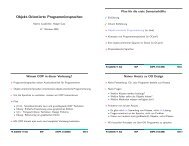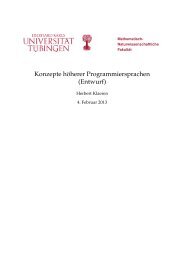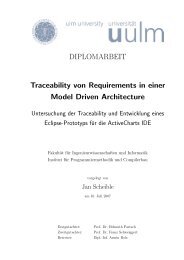Automated Model Quality Rating of Embedded Systems
Automated Model Quality Rating of Embedded Systems
Automated Model Quality Rating of Embedded Systems
Create successful ePaper yourself
Turn your PDF publications into a flip-book with our unique Google optimized e-Paper software.
A quality model can be used to determine the existence <strong>of</strong> desired quality criteria that<br />
characterize a high-quality model. It provides a way <strong>of</strong> looking at models that permits<br />
a statement regarding their quality. Consequently the quality model defines our notion<br />
<strong>of</strong> model quality. If a model fulfills all quality criteria it is <strong>of</strong> high quality. Our quality<br />
model is structured like the quality model <strong>of</strong> Cavano and McCall in [CM78]. Factors that<br />
influence model quality are defined and specific criteria are used to determine whether<br />
these factors are fulfilled. To what extent these criteria are fulfilled is measured by means<br />
<strong>of</strong> metrics. A quality model therefore has the structure <strong>of</strong> a tree, whose leaves represent<br />
the metrics. Our quality model currently consists <strong>of</strong> 6 factors, 17 criteria, and 43 metrics.<br />
Thanks to its tree-like structure, a quality model can be extended to include any number<br />
<strong>of</strong> factors, criteria, and metrics.<br />
<strong>Quality</strong> assurance must be an integral part <strong>of</strong> the entire development process from<br />
start to finish. The goal is to detect errors as early as possible in the development process,<br />
as corrections applied at this stage only involve a limited number <strong>of</strong> development phases<br />
[FLS01]. In addition, this forward-looking approach reduces the cost <strong>of</strong> maintenance and<br />
support. This paper discusses embedding the quality model in the development process<br />
by establishing the relation between the most important artifacts in the model-based<br />
development process and the quality model itself. We then proceed to describe model<br />
quality rating <strong>of</strong> the analyzed models and trend analysis. Finally, we give an overview<br />
<strong>of</strong> our prototypical implementation and further evaluation <strong>of</strong> our approach.<br />
2 Embedding the <strong>Quality</strong> <strong>Model</strong> in the Development Process<br />
Previously (see [Sch10] and [SK10]), the focus <strong>of</strong> the quality model lay on the Simulink<br />
models themselves. However, model quality cannot be sufficiently assessed by only<br />
looking at the model itself; other artifacts in the development process must also be<br />
considered. Even when all modeling guidelines are fulfilled, complexity per subsystem<br />
is low, and the model fulfills all other statically verifiable quality criteria, there is still no<br />
guarantee that the model possesses the desired functionality. The functionality can only<br />
be verified through a manual model review or functional test. This is why other artifacts<br />
must be considered in model quality rating.<br />
Figure 1 shows a simplified V-model with the most important artifacts from the point<br />
<strong>of</strong> view <strong>of</strong> model-based development. The rotating arrow in the middle <strong>of</strong> the process<br />
indicates that we are dealing with an iterative procedure.<br />
The artifacts in the process are all in relation to each other. Thus all requirements<br />
must be implemented in the model and test specifications must exist for all the requirements.<br />
These test specifications must in turn be implemented in the form <strong>of</strong> test<br />
implementations. In initial iterations, only a few requirements are implemented in the<br />
model and only a portion <strong>of</strong> test specifications exist. Towards the end <strong>of</strong> development, all<br />
requirements must have been implemented in the model and all test specifications with<br />
their test implementations will have been created. We are then able to make a statement<br />
regarding the status <strong>of</strong> implementation <strong>of</strong> functionality based on the degree <strong>of</strong> coverage<br />
<strong>of</strong> individual artifacts in relation to each other.








